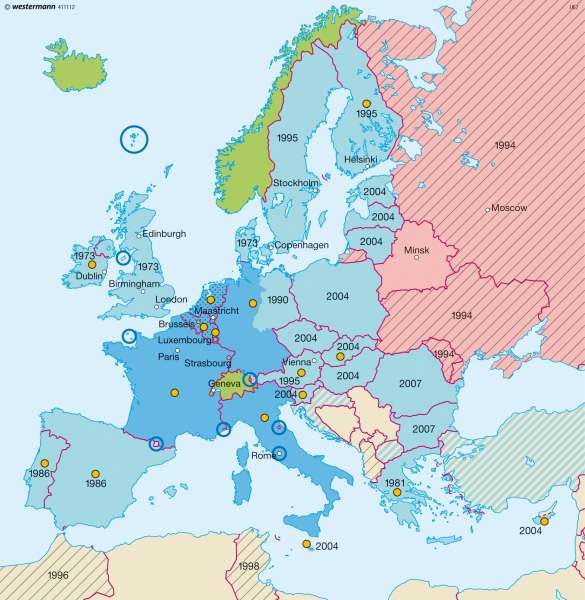European confederations
Europe - Countries
978-3-14-100790-9 | Page 39 | Ill. 3

Information
The Treaties of Paris and Rome between France, Italy, the Federal Republic of Germany, Belgium, Luxembourg and the Netherlands, which took effect in 1951 and 1958, laid the foundation for the European Economic Community (EEC). Under the terms of the Merger Treaty, the EEC became a part of the European Community (EC), to which Great Britain, Ireland, Denmark Greece, Portugal and Spain acceded between 1973 and 1986.The Single European Market and the CIS
In 1987, the twelve Member States of the European Community resolved to establish a Single European Market in which the "Four Freedoms" were to be realized by 1993: the free movement of goods, capital, services and persons. This required fulfilment of the following prerequisites: the elimination of border controls, the implementation of the principle of freedom of establishment for all EC citizens, the harmonization of laws and standards, the opening of financial and telecommunication markets and the abolition of restrictions on the movement of capital. The Single European Market, which guarantees the Four Freedoms in all Member States, has existed since 1993. Since then, every product introduced to the market in any one EU Member States may be offered in the other Member States as well.
While preparations for the creation of the Single European Market were still in progress, the Commonwealth of Independent States (CIS) was founded by Russia, the Ukraine and Belarus. The former Soviet Republics of Armenia, Azerbaijan, Kazakhstan, Moldova, Tajikistan, Turkmenistan and Uzbekistan joined the Commonwealth soon thereafter, followed by Georgia in 1994. Relations among the CIS states soon cooled, however. Uzbekistan and Georgia withdrew from the security pact, while Azerbaijan and Moldova sought to establish ties with NATO. In 2000, Russia reinstated visa requirements for citizens of Azerbaijan, Georgia and Moldova, defending the measure as a necessary means of combating organized crime and terrorism.
The Community of Fifteen
The European Union (EU) was created from the European Community by the Maastricht Treaty of 1993. The goals of the EU included the development of a common foreign and security policy and the creation of an economic and monetary union. The Treaty on the European Economic Region (EER) came into force in 1994. The agreement was signed by all EU Member States as well as the EFTA countries (Switzerland, Norway, Sweden, Finland, Iceland, Austria and Liechtenstein). The European Free Trade Association (EFTA) had been founded in 1960 with the aim of promoting free trade among its member states and 23 associated nations around the world. A number of EFTA members have since acceded to the EU, and the Association is now composed of only four countries: Norway, Iceland, witzerland and Liechtenstein.
Three of these countries were Sweden, Finland and Austria, all of which joined the European Union on January 1, 1995, bringing the number of EU Member States to 15. While good progress was achieved in efforts devoted to establishing the Economic and Monetary Union, cooperation in the areas of domestic and foreign policy was less than satisfactory. Following a revision of the EU Treaty, the Member States signed the Treaty of Amsterdam on October 2, 1997. The purpose of the new agreement was to strengthen the union by reforming its institutions. Although the treaty enhanced the democratic legitimacy of the EU, the reform measures soon became the focus of criticism in the media and among concerned individuals and organizations, particularly in view of the anticipated expansion of the EU following the political upheavals in the East. Negotiations with candidates for accession — Poland, Estonia, the Czech Republic, Slovenia, Hungary and Cyprus with Poland — began in March 1998, and talks with representatives of Latvia, Lithuania, Bulgaria, Romania, Malta and the Slovak Republic were initiated in 1999.
Eastern Expansion, phases I and II
The admission of Estonia, Latvia, Poland, the Czech Republic, the Slovak Republic, Hungary, Slovenia, Malta and Cyprus to the European Community was celebrated at events and festivals in numerous European cities on May 1, 2004. Eastern Expansion represented an historic opportunity for the EU, as the accession of countries that had long been separated from Western Europe by the Iron Curtain represented a significant contribution to the goal of overcoming the rift between East and West. It also posed an economic challenge, since the accession of relatively poor countries with substantial economic and social deficits fuelled concerns about cheap competition and increasing competitive pressure. Yet it soon became evident that the opening of the EU to the East, with its tremendous demand for goods and services, also offered huge opportunities.
Negotiations with Bulgaria were completed within weeks of the end of first phase of Eastern Expansion, and talks were concluded with Romania in December 2004. Following approval by the European Commission, the European Parliament and the Council, the Treaty of Accession was signed by Bulgaria and Romania in Luxembourg on April 25, 2005 and subsequently ratified by the 25 Member States. Thus both countries joined the EU as planned on January 1, 2007, raising the number of Member States to 27. In accordance with a provision of the Treaty of Union, Germany exercised its option to restrict the freedom of employment and provision of services in certain sectors, such as the construction industry, for a transition period of two years. Such restrictions may be imposed for a maximum period of seven years.
D. Bode, K. Lückemeier; Ü: J. Southard




